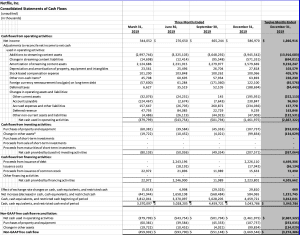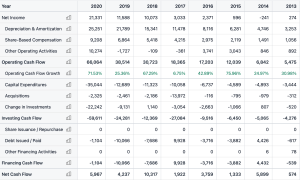
It occurs when expenses, including operating costs, debt repayments, and other financial obligations, surpass the income generated from sales, investments, or other sources. Negative cash flow can pose significant challenges for an organization’s sustainability and growth prospects as it may lead to borrowing or depleting reserves to cover the shortfall.
It can also be a temporary situation for startups or businesses undergoing expansion, but if left unchecked, it can lead to financial instability and potential bankruptcy or insolvency.
Therefore, managing cash flow effectively is essential for ensuring the long-term financial health of any entity and avoiding detrimental consequences
What Does Negative Free Cash Flow Mean?
Negative free cash flow refers to a financial situation where a company’s cash outflows exceed its cash inflows after accounting for operating, capital, and non-cash expenses. In simpler terms, it means that the company is spending more money than it is generating from its regular business operations, investments, and adjustments for non-cash items like depreciation.
This deficit in cash flow can be a cause for concern as it indicates that the company does not have any excess cash on hand to cover its financial obligations or invest in growth opportunities. A persistent negative free cash flow can signal poor financial health and may lead to challenges in meeting debt obligations or funding future projects.
Companies experiencing this condition may need to reevaluate their operational efficiency, manage capital expenditures more prudently, or explore strategies to increase revenues.
Example:
Company XYZ, a tech startup, reported its financial results for the year. During this period, the company earned £8 million in revenue. However, after accounting for operating expenses, employee salaries, and other costs, the company’s cash flow from operations was £6 million. Additionally, the company invested £4 million in new equipment and technology to support its growth.
After considering depreciation of £2 million, the company’s free cash flow turned out to be negative £2 million (£6 million – £4 million – £2 million). This negative free cash flow may raise concerns for investors and lenders, as the company may struggle to fund its operations and expansion plans without resorting to external financing.
Does this imply the business is underperforming?
For emerging enterprises, negative free cash flow is often a consequence of continuous reinvestments to fuel their expansion.
In such cases, negative free cash flow can be viewed positively if these reinvestments are expected to accelerate revenue growth and improve profit margins in the near future. Therefore, to determine the implications of negative free cash flow for your business, it is crucial to consider the following factors:
- What stage of the corporate lifecycle is your business currently in?
- What is the underlying cause behind the negative free cash flow?
- What types of capital investments is the company making?
- What is the source of funding for these investments? By carefully evaluating these aspects, one can gain a better understanding of whether negative free cash flow is a favorable or unfavorable sign for the business.
Why is Negative Cash Flow Not Always Bad?
Contrary to common perception, negative cash flow is not always a detrimental sign for a business. In specific scenarios, negative cash flow can be a strategic and temporary outcome that fosters future growth and profitability. Young and growing companies often prioritize reinvesting their cash into essential areas such as research and development, marketing, or expanding operations.
These strategic investments may result in short-term negative cash flow but have the potential to generate higher revenues and improved margins in the long run. Additionally, companies undergoing significant expansion or acquisition activities may experience temporary negative cash flow as they invest in new assets and capabilities. As long as these investments are well-planned and expected to yield substantial returns, negative cash flow during these periods can be considered a rational business decision.
Moreover, some industries, like real estate development or infrastructure projects, typically involve large upfront investments and longer gestation periods before generating positive cash flow.
In such cases, negative cash flow in the initial stages is a natural part of the business cycle. It is essential to analyze the underlying reasons for negative cash flow and the company’s overall strategy before making any judgments about its financial health
Three Types of Negative Cash Flow
Three types of negative cash flow can be encountered by companies, each with its unique implications and significance.
- Initial Negative Cash Flow: Often observed in new and growing businesses, this occurs when companies invest heavily in resources to establish their brand awareness and authority in the market. Such investments can lead to significant cash outflow initially, but they are made with the expectation of yielding high returns in the long term. For investors seeking companies with potential for high returns, this type of negative cash flow can be seen as a positive sign. As the company’s customer base grows and operations mature, the cash inflow is expected to surpass the outflow, making this negative cash flow temporary and a natural part of a new company’s development.
- Temporary Negative Cash Flow: Even established and profitable companies may experience negative cash flow for a short period during their operations. This can happen when businesses decide to adopt expansion strategies, which often involve increasing salaries, hiring new employees, providing dividend growth to shareholders, and incurring other overhead costs. While this may temporarily lead to negative cash flow, it is typically a strategic move to support growth and strengthen the business. Seasonal businesses with fluctuating demand may also encounter temporary negative cash flow, as they invest heavily during peak seasons and experience slower sales during low-demand periods.
- Chronic Negative Cash Flow: This type of negative cash flow is a cause for concern and indicates more significant underlying issues. If a company consistently reports negative cash flow despite being established and expanding, it suggests that the company is either overinvesting or losing money over time. Chronic negative cash flow can lead to unpaid bills, increased layoffs, and potential financial instability. Unless the root cause is addressed promptly, a company facing chronic negative cash flow may struggle to sustain its operations in the long run and experience severe negative consequences for its business.
In conclusion, while negative cash flow can vary in nature and impact, it is essential for companies to assess the reasons behind it and understand its implications in the context of their business strategy and stage of development. Maintaining a steady flow of cash is crucial for business sustainability, and prudent financial management is vital to navigate and overcome temporary negative cash flow situations.
However, negative cash flow alone should not be the sole measure of a company’s success; a comprehensive analysis of various financial and operational factors is necessary for a more accurate evaluation.
Read more: What is the Cash Conversion Cycle
Negative Cash Flow Examples
It’s no surprise that when discussing negative cash flow, prominent names like Netflix and Amazon come to the forefront. However, despite their cash flow statements showing negative figures, a closer examination reveals a more intriguing picture. Let’s delve further to uncover the underlying dynamics.
Netflix – Embracing Growth Amidst Negative Cash Flow
In recent years, Netflix has consistently reported negative cash flow, particularly in 2019. Rather than being a cause for alarm, this trend is a deliberate consequence of the company’s ambitious growth strategy. Netflix invests heavily in content creation, global expansion, and technological advancements to maintain its dominant position in the streaming industry.
These substantial investments initially lead to negative cash flow, but they are instrumental in bolstering Netflix’s subscriber base and enhancing its content library. As a result, the company has successfully positioned itself as a global entertainment powerhouse, demonstrating that negative cash flow can be a strategic approach to long-term success in the ever-evolving digital landscape.
As other streaming platforms like Disney+ Hotstar and Apple TV+ entered the market, Netflix experienced a decline in its subscriber rate. In response to this growing competition, Netflix took strategic measures to stay relevant and competitive. It significantly expanded its streaming collection, leading to a rise in the cost of creating new content assets, which impacted its negative cash flow.
Moreover, during that period, Netflix increased its investing activities, contributing further to negative cash flows. This raised concerns among investors, with some fearing that Netflix was burning through its cash reserves. The company heavily relied on debt to finance its investment activities during this time.
Despite the cash imbalance and investor worries, Netflix’s management remained confident in their long-term vision. They believed that these investments were crucial for the company’s profitability in the future. The costs incurred in purchasing new content assets were expected to pay off through an increase in subscribers over the following years.
This was especially true for international markets, where analysts forecasted Netflix to become more profitable. In 2020, these strategic decisions started bearing fruit, and the company began to experience positive net cash flows. With an impressive 159.39% increase from 2019, Netflix showcased its ability to navigate challenges and capitalize on its investments for future growth and profitability
Amazon – The Reality Behind its Negative Cash Flow
Over the past few years, this thriving eCommerce giant has diligently managed its financial affairs, resulting in negative cash flow from financing and investing activities, as evident from the statement below. Despite this appearance, a deeper analysis reveals a well-thought-out strategy underpinning these financial decisions.
This company has been strategically investing in innovative technologies, expanding its market reach, and fortifying its supply chain to stay ahead in the fiercely competitive eCommerce landscape. While these investments may lead to temporary negative cash flow, they are instrumental in solidifying the company’s long-term position and driving sustained growth. The management remains resolute in their vision, anticipating these well-placed bets to yield substantial returns and profitability in the coming years.
Thus, this seemingly negative cash flow is a testament to the company’s commitment to innovation and its unwavering pursuit of becoming a true industry leader.
Despite the apparent concern of a significant cash outflow, Amazon’s financial situation becomes much clearer upon closer examination. The primary reason behind the company’s negative cash flow lies in its strategic approach to reinvesting its profits swiftly into pioneering products and ventures.
Through continuous capital expenditures and leveraging debt, Amazon prioritizes innovation, expanding its distribution network, constructing data centers, and diversifying into new lines of business like AWS cloud computing. This unwavering drive for constant growth and progress has garnered the attention of growth investors who see the company’s potential for future success.
Amazon deliberately maintains low reported profits by reinvesting internally, allowing it to benefit from reduced tax burdens. Consequently, the company’s free cash flow remains remarkably robust. A glance at its balance sheet reveals that Amazon holds ample cash reserves and liquid assets readily available, ensuring it possesses a strong financial foundation.
This strategic approach to managing cash flow underscores Amazon’s commitment to maintaining a competitive edge in the market and embracing opportunities for long-term prosperity, which is why the seemingly alarming negative cash flow is, in fact, a calculated and advantageous position for the company.
During the years spanning from 2018 to 2020, the company encountered a period of reporting negative cash flow from investing and financing activities. However, amidst this apparent challenge, a closer examination unveils a bright side to the story. Surprisingly, Amazon’s cash and liquid assets showcased steady growth throughout this time frame.
This impressive feat owes much to Amazon’s ingenious payment cycle, which enables the company to receive payments from customers at a much earlier stage compared to its payments to suppliers. By reducing its cash conversion days, Amazon secures a continuous influx of funds even before the last quarter’s bills are due, effectively maintaining consistently higher levels of free cash flow.
Jeff Bezos heralds free cash flow as the paramount financial metric, wielding its evaluative prowess over the company’s financial triumphs, driven chiefly by two pivotal reasons:
- Empowered by an abundance of available cash, Amazon transcends conventional limits, utilizing its financial resources beyond routine obligations. Beyond ensuring timely payments to suppliers, employees, and shareholders, this surplus capital becomes a potent catalyst for strategic investments in shaping the company’s future trajectory.
- Revered by investors as a superior yardstick of a company’s stock valuation, free cash flow emerges as the vanguard for determining true financial health. More than mere profitability, this formidable metric resonates deeply with investors, encapsulating the company’s robust financial resilience and potential for sustained growth.
Concealed within Amazon’s seemingly low profit and negative cash flow lies a tale of triumph and accomplishment. These real business cases serve as poignant reminders, illuminating the inadequacy of relying solely on a cash flow statement to gauge a company’s genuine profitability and performance accurately.
Indeed, the key to financial foresight lies in obtaining financing during periods of healthy cash flows, affording companies the ability to meticulously plan and prepare for future expenses, safeguarding them from the perils of negative cash flows.
Hence, the implementation of robust cash flow management strategies assumes paramount importance for businesses, ensuring a steady course towards prosperity and shielding them from unwelcome financial setbacks.
Frequently asked questions
What happens if cash flows are negative?
If cash flows are negative it means inflow does not match expenses, causing the business to spend more cash than it takes in. Depending on your company's operations, you might experience poor cash flow at different points.
What does a negative cash flow mean for investors?
A negative cash flow mean for investors that a company spends more cash on its investing activities than it receives from them. This means that the company is using its cash to buy or improve its fixed assets, such as buildings, machinery, or technology.
Conclusion
In conclusion, negative cash flow can significantly impact a business’s financial health and sustainability. While certain cases of negative cash flow may be strategic and temporary, such as during periods of expansion and investments, chronic negative cash flow can be a cause for concern.
A persistent deficit in cash flow may lead to financial instability, making it challenging for a company to meet its financial obligations, pay suppliers and employees on time, or invest in future growth opportunities. Relying heavily on debt to finance operations can also result in higher interest expenses and increased financial risks.
In extreme cases, chronic negative cash flow can even lead to bankruptcy and the eventual collapse of a business. Therefore, businesses must carefully analyze the reasons behind negative cash flow, implement effective cash flow management strategies, and strike a balance between investments and profitability to ensure their long-term success and resilience in the dynamic market landscape.
Seasoned professional with a strong passion for the world of business finance. With over twenty years of dedicated experience in the field, my journey into the world of business finance began with a relentless curiosity for understanding the intricate workings of financial systems.



